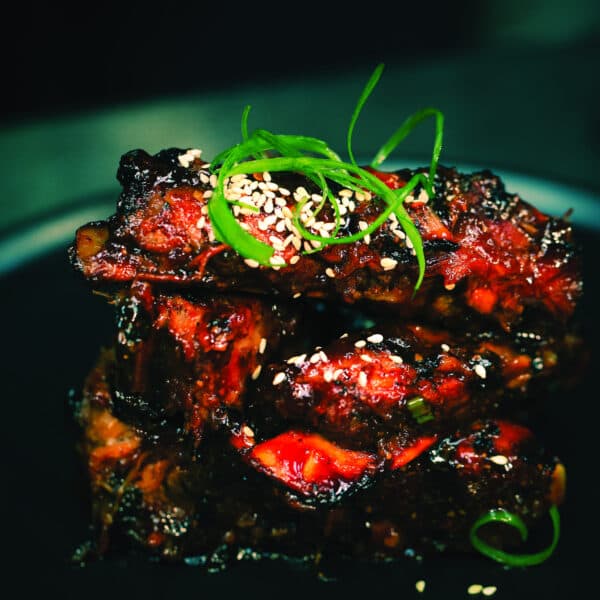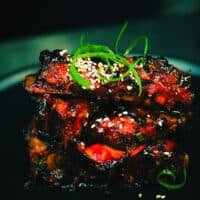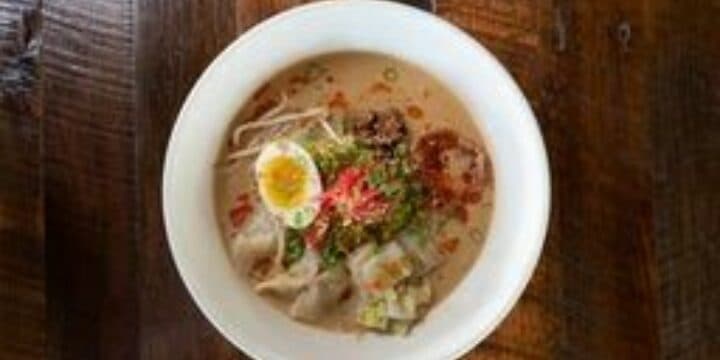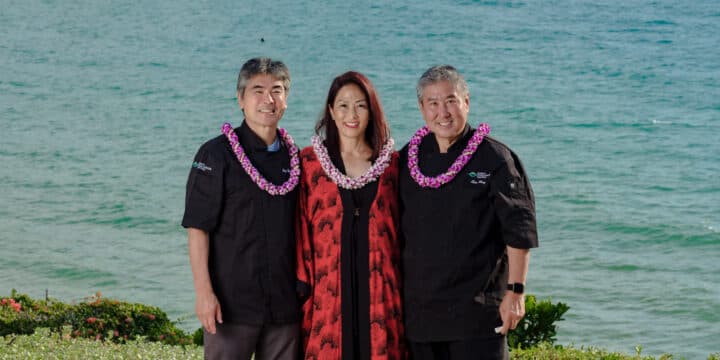Grassroots Fine Dining
Roy Yamaguchi's profound impact on Hawai‘i food culture
BY Sydney Marie Lutes
Perfectly sugared malasadas, generous plate lunches, ruby red ‘ahi poke bowls—Hawai‘i is home to an iconic collection of foods that people travel far and wide to experience. While these casual bites will forever be the choice selection for a midday, beachside snack, Hawai‘i’s thriving fine dining scene has recently become the main gastronomic attraction.
When searching for a Saturday night reservation promising an exceptional experience of epicurean intrigue, you’d be hard-pressed to find a search engine or a long-time Hawai‘i resident who would suggest something outside of Chef Roy Yamaguchi’s establishments. The reputation of this James Beard award-winning chef is well-earned. From competing on Top Chef Masters and serving as a judge on Hell’s Kitchen to earning rightful placement in the Fine Dining Hall of Fame and world-renowned magazines like Bon Appétit and Food & Wine, Chef Roy has become a celebrity chef to admire.
Before the onset of fame, a global cookware brand, and thousands-of-copies-sold cookbooks, Chef Roy kickstarted his culinary career with no intent on capturing celeb-status. In fact, his introduction to food and his defining philosophy on food are of a very grassroots kind.
During the early 1940s, Chef Roy’s paternal grandfather left his childhood home of Japan to move to the island of Maui where he worked on a plantation. He eventually opened a small collection of food establishments where his fellow plantation workers would enjoy generous portions of noodles, rice, and stews for pennies on the dollar. With these eateries, his grandfather pioneered what became a paternal lineage of passionate gastronauts. From assisting with the running of these establishments to preparing dinner five to six nights a week for his family, Chef Roy’s father adopted his father’s love of food. As the third member of the lineage, Chef Roy witnessed his own father’s experimentation in the kitchen and accompanied his grandfather on trips to local farms and markets. While he jokes that he once had dreams of being a rockstar after a short stint playing the drums in high school, Chef Roy’s love of food captivated him at an early age.
After graduating from the Culinary Institute of America in New York, Chef Roy went on to work at some of the most prestigious restaurants in California at the time. His naturality and innovation in the kitchen heightened during this post-graduation period, and he opened his very first restaurant in 1984. While this first endeavor earned rave reviews and lasting success, Chef Roy knew purpose and fulfillment awaited him in Hawai‘i.
The Hawai‘i food culture and ecosystem captivated Chef Roy. Converged within small plots of isolated land in the middle of the Pacific Ocean were abundant supplies of ingredients rich in history and flavor. From the Polynesians thousands of years ago to international voyagers, such as his grandfather in more recent times, this land assembled one of the most dynamic food offerings in the world.
With his professional culinary experience and enchantment with Hawaiian food culture, Chef Roy moved to Honolulu in 1988 where he opened the first of his now-iconic Roy’s Restaurants. At this time in Hawai‘i, a collection of local chefs—including Alan Wong, Sam Choy, and Peter Merriman—connected over a common passion for restoring and elevating the Hawai‘i cuisine. Originating from different backgrounds and practicing different preparations, these chefs all yearned to create a unique blending of multicultural dishes using locally-sourced ingredients which eventually led to the Hawai‘i Regional Cuisine Movement. This grassroots movement relied on partnerships between fellow stewards of the islands: ranchers, farmers, and fishermen. For a promise to purchase, these local suppliers would grow, raise, and harvest products of the chefs’ choosing.
Through this partnership, culinary innovation flourished with a defining Hawaiian spirit. Hawaiian fusion cuisine became a trademark with notoriety and recognition but also welcomed fluidity as cultures and cuisines blended. These chefs and new generations of chefs thereafter tested the limits of this cuisine with upscale preparations and fine dining experiences—global recognition as a culinary destination followed. In today’s Hawai‘i, visitors plan to book nightly reservations up to a month in advance as the fine dining scene continues to attract higher volumes of people yearning to get a taste.
As a pioneer of this Hawai‘i food revolution, Chef Roy witnessed the widespread impact. Not only did the collection of upscale offerings expand, but diverse eateries rooted in authentic Hawaiian adaptions also surged. Gourmet food trucks, bento-style cafes, and farmers markets stand to serve as a testament to the rich food scene Hawai‘i now offers and is recognized for.
Inspired by the myriad thriving Hawai‘i-based operations, Chef Roy co-founded the Hawai‘i Food & Wine Festival in 2011 with Alan Wong. With the goal of supporting sustainability, culinary educational programs, and agriculture, this festival has donated more than $3 million to community organizations while also offering international guests a world-class epicurean experience. In standard Chef Roy humility, he owes a large part of the success of this venture to his wife, Denise. With her expertise in community and governmental affairs, they curated the idea for this festival on the basis of celebrating Hawai‘i in an authentic way. The differentiator was that they wanted the Hawai‘i Food & Wine Festival to serve as a not-for-profit function without any marketing commitments to one entity. They constructed this program to serve as a true representation of the people of Hawai‘i and their distinguishing commitment to work together in pursuit of growth.
Chef Roy’s passion for community weaves through every venture he tackles. From the level of care provided to guests at his restaurant to his far-reaching philanthropic efforts, and finally to his most recent venture as a lecturer at the University of Hawai‘i at Mānoa. While his accolades and awards deem a stratum beyond that of the everyday individual, his humility and genuine passion for doing good is resounding.
When speaking of the Hawai‘i Food & Wine Festival, he points to his wife, Alan Wong, and the ambitious participants for its success. When asked about the Hawai‘i cuisine that he worked tirelessly to co-pioneer, he points to the other chefs within his circle. When describing the success of his restaurants, he pays tribute to the farmers, ranchers, and fishermen of Hawai‘i that supply fresh ingredients “that just taste better.”
Chef Roy has checked all the boxes outlined on aspiring chefs’ manifestation journals, leaving people to wonder what is next. For him, the answer is to continue learning: about himself, about the industry, about people, about any offering that presents itself. An insatiable hunger to better the paths he’s already paved leads Chef Roy into his next adventures, and until the rest of the world is lucky enough to find out what truly is next, the hard-earned fruits of his labor will continue to inspire the next generations of chefs, entrepreneurs, and philanthropists.
You May Like
More from Roy Yamaguchi

Eat + Drink
Eating House 1849
Local comfort food at its finest at this Roy Yamaguchi gem
Features

Eat + Drink







